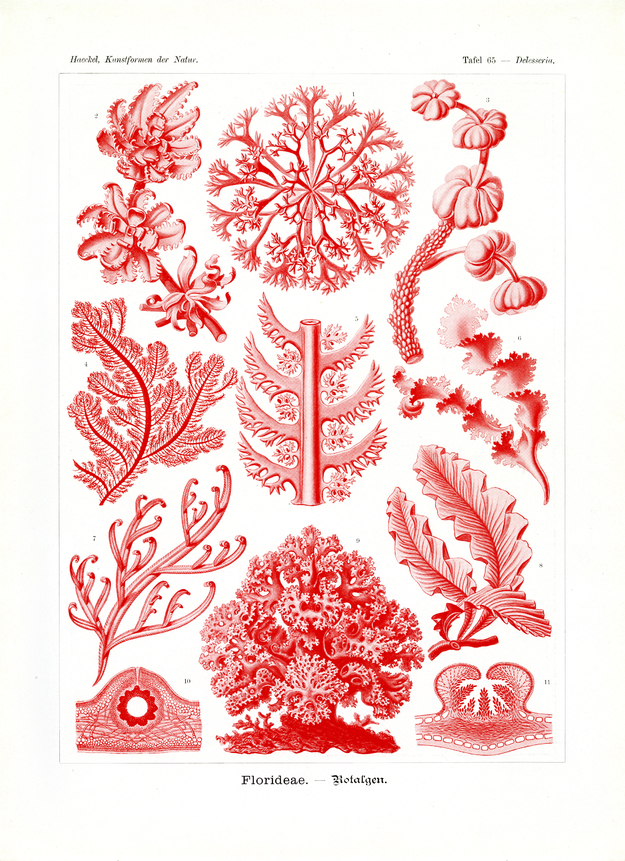Translation of the original German introduction by Ernst Haeckel:
Division of Algae (Tange); - class of Florideae or Rhodophyceae (Rotalgen).
Due to the beautiful red coloration of the entire plant body as well as the manifold and delicate shape of this “Thallus” Florideae are strikingly distinguished from all other water plants. Most species of the huge class inhabit the sea, only few are found in fresh water. Although the foliage or Thallus of these Algae is not yet separated into stem and leaves, as it is the case in the higher plants (mosses, ferns and flowering plants), many species imitate the outer forms of the latter prominently through sprout formation and branching. The inner ‘tissue-frame’, however, is simple compared to higher plants. The multi-cellular tissue may be separated into inner and outer layer (fig. 10, 11), yet, it does not form “vessels”.
The strikingly red coloration of the entire Thallus in the numerous species of Florideae presents the most manifold nuances and color shades. In the majority of Florideae the overall coloration is a shade of lighter or darker rose red; many a times it blends into carmine, purple and violet or reddish brown; in other species red takes a tinge of orange or reddish yellow, at times green as well or a mix of these shades. Source of the red coloration is a particular pigment, Phycorhodin (also known as Phycoerythrin or Rhodophyll). It covers the ‘plasmodomeous’, round- or disc-shaped, green Chlorophyll-grains that are, as in most plants, accumulated inside the cells. The green colour of the latter is, however, completely covered by the red colour of Florideae; it becomes visible only when the red colour gets extracted due to exposure to freshwater for an extended period of time.
Florideae are further distinguished from other Algae by the peculiar conditions of their reproduction; they have a regular alteration of generation similar to the one found in mosses and ferns. The sexual generation (“Gamophyt”) forms ovocytes that are fertilized by particular ‘sperm-bodies’ (Spermatia); the latter are not, as in other algae, flexible ‘flagella-cells’ but simple, naked, round cells. When the two generative cells (“Gametes”) have copulated and their nuclei coalesced a peculiar ‘fruit sac’ (Cystocarpium, fig. 10, 11) develops out of the fertilized ovocyte (Cytula). The asexual generation (“Sporophyt”) produces numerous “spore-mother-cells” of which each one usually forms four spores (Tetraspores). Out of each spore a Gamophyt emerges.
Translation by VR Translators Bangalore
We've scanned the original lithography at 1200dpi on the Epson A3 scanner of A3 scanner huren. You can download a 400dpi JPEG here.
